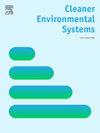Managing nitrogen metabolism of animal husbandry and aquaculture could mitigate nitrogen threat in the main cities of Yellow River Delta
IF 4.9
Q2 ENGINEERING, ENVIRONMENTAL
引用次数: 0
Abstract
Excessive nitrogen input threatens the ecological health of the Yellow River estuary, with the Main Cities in the Yellow River Delta (MCYRD) facing persistent nitrogen management challenges. Previous studies have lacked a detailed characterization of nitrogen metabolism in estuarine and coastal cities, with limited sector-specific assessments, constraining effective management. Based on urban metabolism theory, this study develops a comprehensive nitrogen metabolism model for MCYRD (2015–2023), refining assessments of nitrogen fluxes from extensive animal husbandry and seawater aquaculture. Results show that nitrogen input to the sea fluctuated around 60 Gg, with aquaculture as the dominant contributor (35.53 %) to surface water and the only productive sector with increasing discharge (+5.28 %), followed by animal husbandry (32.00 %). Among them, seawater aquaculture discharged 234.89 % and 508.11 % more nitrogen than inland aquaculture in Binzhou and Dongying, respectively, posing ecological risks due to the lack of wastewater discharge standards, particularly from shellfish farming. Untreated extensive animal husbandry contributed 81.43 % of animal husbandry runoff, with cattle in Binzhou and sheep in Dongying as the major sources, highlighting the urgency of improved manure management. Meanwhile, by enforcing wastewater treatment in aquaculture, MCYRD could cut nitrogen emissions by 13.00 Gg, while fertilizer reduction and livestock intensification offer long-term mitigation potential. Upgrading wastewater treatment technologies remains essential for sustained nitrogen control. Our findings provide a scientific basis for nitrogen pollution management in MCYRD, supporting targeted strategies for coastal ecosystem protection.
管理畜牧业和水产养殖业的氮代谢可缓解黄河三角洲主要城市的氮威胁
过量的氮输入威胁着黄河入海口的生态健康,黄河三角洲主城面临着持续的氮管理挑战。以往的研究缺乏对河口和沿海城市氮代谢的详细描述,对特定部门的评估有限,制约了有效的管理。本研究基于城市代谢理论,建立MCYRD(2015-2023)综合氮代谢模型,对粗放型畜牧业和海水养殖的氮通量评估进行细化。结果表明:海水氮输入量在60 Gg左右波动,养殖业是地表水氮输入的主要来源(35.53%),是唯一增加排放的生产部门(+ 5.28%),其次是畜牧业(32.00%)。其中,滨州和东营市海水养殖的氮排放量分别比内陆养殖高出234.89%和508.11%,由于缺乏废水排放标准,特别是贝类养殖的废水排放存在生态风险。未经处理的粗放型畜牧业占畜牧业径流量的81.43%,其中滨州的牛和东营的羊是主要来源,加强粪便管理的紧迫性突出。同时,通过加强水产养殖废水处理,MCYRD可以减少13.00 Gg的氮排放,而减少肥料和畜牧业集约化具有长期缓解潜力。升级废水处理技术对于持续控制氮仍然至关重要。研究结果可为长江三角洲氮素污染管理提供科学依据,为制定有针对性的沿海生态系统保护策略提供支持。
本文章由计算机程序翻译,如有差异,请以英文原文为准。
求助全文
约1分钟内获得全文
求助全文
来源期刊

Cleaner Environmental Systems
Environmental Science-Environmental Science (miscellaneous)
CiteScore
7.80
自引率
0.00%
发文量
32
审稿时长
52 days
 求助内容:
求助内容: 应助结果提醒方式:
应助结果提醒方式:


